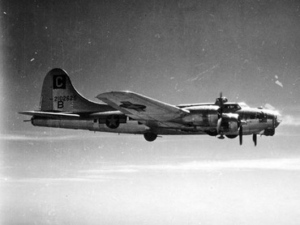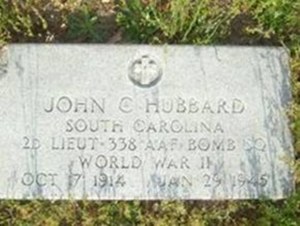Scroll of Honor – John Calhoun Hubbard, Jr.
Takeoff
Written by: Kelly Durham
The missions flown by the heavy bombers of the 8th Air Force were fraught with dangers. Mechanical failures and equipment malfunctions were always a hazard at the high altitudes at which missions were flown. The Germans were an even greater threat with swift, swarming fighter planes and deadly antiaircraft artillery. But sometimes, the most dangerous part of the mission was simply getting off the ground.
John Calhoun Hubbard, Jr. of Bennettsville enrolled at Clemson College as a member of the Class of 1939. After his freshman year on campus, Hubbard left school and took over the Nehi Bottling Plant in his hometown. Over the following years, Hubbard joined the Junior Chamber of Commerce and the Woodmen of the World. He was a member of the Methodist Church and was building a reputation as one of Bennettsville’s outstanding young businessmen. Hubbard was also interested in flying. In his free time, he took flying lessons with a local instructor.
Just two months after Pearl Harbor, Hubbard entered the Army as a private. He qualified for and completed officer candidate school and was commissioned as a second lieutenant. With his flying experience, he applied for and was accepted into flight training at Maxwell Field in Alabama. He graduated to advanced flight training at George Field, Illinois where he earned his pilot’s wings. From there he was ordered to Arkansas where he served as a flight instructor for several months. He was then sent to Texas, Ohio, Nebraska, and Louisiana for additional training.
 Hubbard was soon ordered back to Nebraska where he received additional training in combat flying in preparation for deployment to Europe. In December 1944, Hubbard arrived in England as a pilot assigned to the 388th Bomb Squadron, an 8th Air Force unit stationed at Snetterton Heath in the southeastern part of the country.
Hubbard was soon ordered back to Nebraska where he received additional training in combat flying in preparation for deployment to Europe. In December 1944, Hubbard arrived in England as a pilot assigned to the 388th Bomb Squadron, an 8th Air Force unit stationed at Snetterton Heath in the southeastern part of the country.
The 388th, like the rest of the 8th Air Force, was fighting an aerial war not only against the Germans but also against what Masters of the Air author Donald Miller calls “one of the most capricious weather systems in the world.” Fog and clouds often extended from ground level up to 20,000 feet or more. Low clouds meant that pilots had to fly blind—using only their flight instruments—to navigate to a clear altitude and join their assigned formations.
By the time Second Lieutenant Hubbard began flying combat missions, the 8th was regularly launching operations composed of hundreds of heavy bombers. With nearly a hundred 8th and 9th Air Force bases concentrated in southeastern England, and with bombers taking off every thirty seconds from the area’s many runways, the takeoff and climb into formation could be as dangerous as the flight across the English Channel and over German-occupied Europe.
On January 29, 1945, the 8th Air Force launched 1,158 bombers toward industrial targets in Germany. In addition, 700 fighters were dispatched to escort the bombers. This vast armada filled the airspace above East Anglia. That morning, Hubbard was the copilot of a 388th B-17 piloted by Second Lieutenant Alex Philipovich. As their aircraft climbed into the murky sky, it collided with another B-17 from its sister squadron the 337th. Both aircraft were destroyed and their crews killed. On that day, the 8th recorded seventeen non-combat accidents, including eight takeoff accidents. Mercifully, not all of them were fatal.
accidents, including eight takeoff accidents. Mercifully, not all of them were fatal.
John Calhoun Hubbard, Jr. was survived by his parents, his wife, and their daughter. After the war, his remains were returned to Bennettsville and interred in McCall Cemetery.
For more information on Second Lieutenant John Calhoun Hubbard, Jr. see:
https://soh.alumni.clemson.edu/scroll/john-calhoun-hubbard-jr/
For additional information about Clemson University’s Scroll of Honor visit:
https://soh.alumni.clemson.edu/
See also Masters of the Air: America’s Bomber Boys Who Fought the Air War Against Nazi Germany by Donald L. Miller.
